| Structure | Information | |
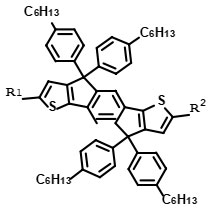 |
R1=R2=H |
Br-D1001 CAS: M F: C64H74S2 M W: 907.40 |
| R1=R2=Br | Br-D1001 CAS: 1049034-71-0 M F: C64H74Br2S2 M W: 1065.19 |
|
R1=R2=CHO |
Br-D1003 CAS: 1884694-93-2 M F: C66H74O2S2 M W: 963.42 |
|
| R1=Br R2=CHO | CAT: GT004 CAS: M F: C65H73BrOS2 M W: 1014.31 |
|
R1=R2= |
CAT: GT005 CAS: 2095504-33-7 M F: C90H82N4O2S2 M W: 1315.77 |
|
R1=R2=  |
CAT: GT006 CAS: M F: C92H86N4O2S2 M W: 1343.82 |
|
R1=R2=  |
CAT: GT007 CAS: M F: C90H80F2N4O2S2 M W: 1351.75 |
|
R1=R2=  |
CAT: GT008 CAS: M F: C90H78F4N4O2S2 M W: 1387.73 |
|
R1=R2=  |
CAT: GT009 CAS: M F: C90H78Cl4N4O2S2 M W: 1453.55 |
|
| Structure | Information | |
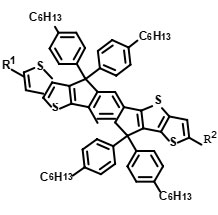 |
R1=R2=H |
CAT: GT010 CAS: 1420071-64-2 M F: C68H74S4 M W: 1019.58 |
| R1=R2=Br | CAT: GT011 CAS M F: C68H72Br2S4 M W: 1177.37 |
|
R1=R2=CHO |
CAT: GT012 CAS M F: C70H74O2S4 M W: 1075.60 |
|
| R1=Br R2=CHO | CAT: GT013 CAS: M F: C69H73BrOS4 M W: 1126.48 |
|
R1=R2= |
CAT: GT014 CAS: 1664293-06-4 M F: C94H82N4O2S4 M W: 1427.94 |
|
R1=R2=  |
CAT: GT015 CAS: 2107971-73-1 M F: C96H86N4O2S4 M W: 1456.00 |
|
R1=R2=  |
CAT: GT016 CAS: M F: C94H80F2N4O2S4 M W: 1463.92 |
|
R1=R2=  |
CAT: GT017 CAS: M F: C94H78F4N4O2S4 M W: 1499.90 |
|
R1=R2=  |
CAT: GT018 CAS: M F: C94H78Cl4N4O2S4 M W: 1565.72 |
|
| Structure | Information | |
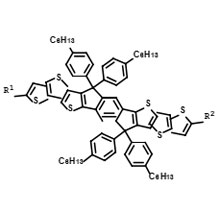 |
R1=R2=H |
CAT: GT019 CAS M F: C72H74S6 M W: 1131.75 |
| R1=R2=Br | CAT: GT020 CAS M F: C72H72Br2S6 M W: 1289.54 |
|
R1=R2=CHO |
CAT: GT021 CAS M F: C74H74O2S6 M W: 1187.77 |
|
| R1=Br R2=CHO | CAT: GT022 CAS: M F: C73H73BrOS6 M W: 1238.65 |
|
R1=R2= |
CAT: GT023 CAS M F: C100H90N4O2S6 M W: 1572.20 |
|
R1=R2=  |
CAT: GT024 CAS M F: C102H94N4O2S6 M W: 1600.25 |
|
R1=R2=  |
CAT: GT025 CAS: M F: C100H88F2N4O2S6 M W: 1608.18 |
|
R1=R2=  |
CAT: GT026 CAS: M F: C100H86F4N4O2S6 M W: 1644.16 |
|
R1=R2=  |
CAT: GT027 CAS: M F: C100H86Cl4N4O2S6 M W: 1709.98 |
|
| Structure | Information | |
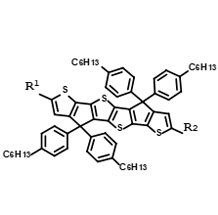 |
R1=R2=H |
CAT: GT028 CAS M F: C64H72S4 M W: 969.52 |
| R1=R2=Br | CAT: GT029 CAS M F: C64H70Br2S4 M W: 1127.31 |
|
R1=R2=CHO |
CAT: GT030 CAS M F: C66H72O2S4 M W: 1025.54 |
|
| R1=Br R2=CHO | CAT: GT031 CAS: M F: C65H71BrOS4 M W: 1076.42 |
|
R1=R2= |
CAT: GT032 CAS M F: C90H80N4O2S4 M W: 1377.88 |
|
R1=R2=  |
CAT: GT033 CAS M F: C92H84N4O2S4 M W: 1405.94 |
|
R1=R2=  |
CAT: GT034 CAS: M F: C90H78F2N4O2S4 M W: 1413.86 |
|
R1=R2=  |
CAT: GT035 CAS: M F: C90H76F4N4O2S4 M W: 1449.85 |
|
R1=R2=  |
CAT: GT036 CAS: M F: C90H76Cl4N4O2S4 M W: 1515.66 |
|
| Structure | Information | |
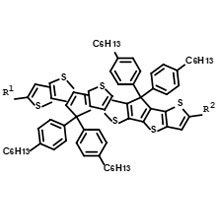 |
R1=R2=H |
CAT: GT037 CAS M F: C68H72S6 M W: 1081.69 |
| R1=R2=Br | CAT: GT038 CAS M F: C68H70Br2S6 M W: 1239.48 |
|
R1=R2=CHO |
CAT: GT039 CAS M F: C70H72O2S6 M W: 1137.71 |
|
| R1=Br R2=CHO | CAT: GT040 CAS: M F: C69H71BrOS6 M W: 1188.60 |
|
R1=R2= |
CAT: GT041 CAS M F: C94H80N4O2S6 M W: 1490.06 |
|
R1=R2=  |
CAT: GT042 CAS M F: C96H84N4O2S6 M W: 1518.11 |
|
R1=R2=  |
CAT: GT043 CAS: M F: C94H78F2N4O2S6 M W: 1526.04 |
|
R1=R2=  |
CAT: GT044 CAS: M F: C94H76F4N4O2S6 M W: 1562.02 |
|
R1=R2=  |
CAT: GT045 CAS: M F: C94H76Cl4N4O2S6 M W: 1627.84 |
|
| Structure | Information | |
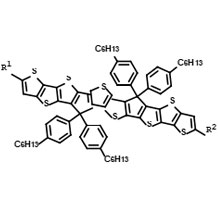 |
R1=R2=H |
CAT: GT046 CAS M F: C72H72S8 M W: 1193.86 |
| R1=R2=Br | CAT: GT047 CAS M F: C72H70Br2S8 M W: 1351.65 |
|
R1=R2=CHO |
CAT: GT048 CAS M F: C74H72O2S8 M W: 1249.88 |
|
| R1=Br R2=CHO | CAT: GT049 CAS: M F: C73H71BrOS8 M W: 1300.77 |
|
R1=R2= |
CAT: GT050 CAS M F: C98H80N4O2S8 M W: 1602.23 |
|
R1=R2=  |
CAT: GT051 CAS M F: C100H84N4O2S8 M W: 1630.28 |
|
R1=R2=  |
CAT: GT052 CAS: M F: C98H78F2N4O2S8 M W: 1638.21 |
|
R1=R2=  |
CAT: GT053 CAS: M F: C98H76F4N4O2S8 M W: 1674.19 |
|
R1=R2=  |
CAT: GT054 CAS: M F: C98H76Cl4N4O2S8 M W: 1740.01 |
|
In the quest for renewable energy sources, Organic Photovoltaics (OPVs) have emerged as a revolutionary technology with the potential to transform the solar energy landscape. OPVs utilize organic molecules as the key building blocks to convert sunlight into electricity, offering a promising alternative to traditional silicon solar cells. With their high efficiency and performance, OPVs are paving the way for a greener and more sustainable future.
At the core of OPV technology is the use of organic molecules as the active materials. These organic molecules, known as OPV donors, possess unique electronic properties that allow them to absorb photons from sunlight and convert them into electric charges. The ability to tailor the properties of these organic donors through chemical synthesis enables researchers to design materials with optimized light absorption and charge transport characteristics.
The efficiency of OPVs is one of their most compelling features. While silicon solar cells have long been the dominant technology with efficiency levels above 20%, OPVs have made significant strides in recent years. Through advancements in material design and device engineering, OPVs have achieved efficiencies exceeding 15%, rivaling other emerging photovoltaic technologies. This remarkable progress has been possible due to the development of high-performance organic molecules and the optimization of device architectures.
The choice of organic molecules as OPV ligands is critical to achieving high performance. These ligands play a crucial role in the absorption of light, charge separation, and charge transport within the solar cell. By carefully selecting and engineering these ligands, researchers can enhance the light absorption range, improve charge carrier mobility, and minimize charge recombination, thereby maximizing the power conversion efficiency of the OPV device.
The unique properties of organic molecules offer several advantages over traditional silicon solar cells. organic solar cells can be fabricated using low-cost solution-based processes, such as printing or coating techniques, which are more scalable and economical compared to the complex and energy-intensive fabrication methods required for silicon-based solar cells. Moreover, organic solar cells can be fabricated on flexible and lightweight substrates, enabling their integration into a wide range of applications, including wearable electronics, portable devices, and even curved surfaces.
Another key advantage of OPVs is their potential for environmental sustainability. organic molecules used in OPVs are derived from readily available and abundant carbon-based sources, making them more environmentally friendly than silicon solar cells, which rely on rare earth materials. Additionally, the low-energy fabrication processes associated with OPVs result in a lower carbon footprint during production.
The development and commercialization of OPVs have been driven by collaborations between academic institutions, research laboratories, and industrial partners. These partnerships have led to significant advancements in organic materials, device engineering, and manufacturing techniques. Donors, including governments, private organizations, and philanthropic foundations, have played a vital role in supporting research and development efforts in the field of OPVs, recognizing their potential for addressing the global energy challenge.
Organic Photovoltaics (OPVs) are revolutionizing the solar energy industry by harnessing the power of organic molecules to create high-performance solar cells. With their high efficiency, lightweight nature, and potential for low-cost production, OPVs offer a promising alternative to traditional silicon solar cells. The ongoing research and development efforts, coupled with the support of donors, are driving the progress of OPV technology, paving the way for a sustainable and renewable energy future.
 E-mail: info@chemborun.com
E-mail: info@chemborun.com Tel: +86-574-87178138
Tel: +86-574-87178138  No. 1558, Jiangnan Road,, Ningbo, Zhejiang, China (Mainland)/31
No. 1558, Jiangnan Road,, Ningbo, Zhejiang, China (Mainland)/31